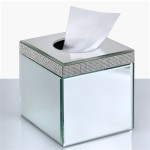Hanging a Frameless Mirror on Drywall
Frameless mirrors offer a sleek, modern aesthetic, enhancing any room with their minimalist design. However, their lack of a traditional frame presents unique challenges when it comes to installation. This article provides a comprehensive guide to securely and effectively hanging a frameless mirror on drywall.
Before beginning the installation process, gather the necessary tools and materials. These typically include a measuring tape, a level, a pencil, mirror adhesive, painter's tape, mirror clips (optional), safety glasses, and gloves. Selecting the appropriate adhesive is crucial. Construction-grade mirror adhesive is specifically designed for this purpose and provides a strong, long-lasting bond. It's important to choose an adhesive that is compatible with both the mirror and the drywall material.
Proper preparation of the wall surface is essential for successful adhesion. Clean the wall area where the mirror will be mounted using a mild cleaning solution and a clean cloth. Ensure the surface is completely dry before proceeding. Any dust, dirt, or grease can compromise the bond between the adhesive and the wall, potentially leading to the mirror falling and breaking.
Accurate measurement and marking are critical for achieving a level and centered installation. Use a measuring tape to determine the desired position of the mirror on the wall. Lightly mark the top center point with a pencil. Using a level, extend this mark horizontally to create a level line representing the top edge of the mirror. Measure and mark the desired width of the mirror along this line, ensuring symmetrical placement. From these points, use the level to draw vertical lines down to the desired bottom edge of the mirror, completing the outline.
Applying the adhesive correctly is paramount to the mirror's secure attachment. Following the manufacturer's instructions, apply the adhesive to the back of the mirror. The adhesive should be applied in vertical lines or a grid pattern, ensuring even coverage across the mirror's surface. Leave a small border around the perimeter of the mirror free of adhesive to prevent it from squeezing out and becoming visible during installation.
Carefully position the mirror against the marked outline on the wall. Use firm, even pressure to adhere the mirror to the drywall. It's recommended to have an assistant help with this step, especially for larger or heavier mirrors. Double-check the positioning using a level to ensure it remains aligned correctly during the bonding process. Hold the mirror in place for the duration recommended by the adhesive manufacturer.
While the adhesive sets, securing the mirror with painter's tape provides additional support and prevents slippage. Apply strips of painter's tape across the mirror's surface, connecting it to the wall. This provides temporary reinforcement while the adhesive cures completely. The tape can typically be removed after 24 to 48 hours, depending on the adhesive's curing time.
For added stability, especially with larger or heavier mirrors, consider using mirror clips. These clips are designed to secure the mirror to the wall and provide extra support against movement or shifting. Install the clips along the bottom and sides of the mirror, ensuring they are firmly attached to both the mirror and the wall. Choose clips that are appropriately sized and weight-rated for the specific mirror being installed.
Different types of drywall may require specific considerations during the installation process. Standard drywall is generally suitable for hanging frameless mirrors using the methods described. However, for thinner drywall or walls with potential moisture exposure, using additional support mechanisms, like a backing board or reinforced anchors, may be necessary to ensure a secure and lasting installation.
Troubleshooting potential issues is crucial for a successful outcome. If the adhesive begins to squeeze out from behind the mirror during installation, carefully wipe it away with a damp cloth before it dries. If the mirror becomes misaligned, gently reposition it while the adhesive is still wet. If the mirror is significantly misaligned or if the bond fails, carefully remove the mirror, clean the surfaces, and repeat the adhesive application process. If the wall surface is damaged during removal, repair it before attempting to re-hang the mirror.
Maintaining the mirror's cleanliness and appearance requires regular care. Clean the mirror surface with a glass cleaner and a soft, lint-free cloth. Avoid using abrasive cleaners or materials that could scratch the mirror's surface. Regularly inspect the mirror and its mounting for any signs of loosening or damage. If any issues are detected, address them promptly to prevent further damage or potential hazards.
Safety precautions are essential throughout the installation process. Always wear safety glasses and gloves when working with adhesives and handling glass. Ensure adequate ventilation in the work area. If working with larger or heavier mirrors, seek assistance to prevent accidents or injuries. Follow the manufacturer's instructions for both the adhesive and any additional mounting hardware used.

How To Install A Mirror Without Frame Merrypad

How To Hang A Frameless Mirror On The Wall With Pictures

How To Hang A Frameless Mirror On The Wall With Pictures

How To Hang A Frameless Mirror June 2024 Your Guide Hanging

How To Hang A Frameless Mirror On Wall 3 Methods
:strip_icc()/ScreenShot2022-04-28at1.12.19PM-e055476c70c6438585fa7c5cd531edcf.png?strip=all)
4 Easy Ways To Hang A Heavy Mirror

Here S How To Easily Hang A Frameless Wall Mirror

Mirror Installation Without Clips
Best Way To Attach A Frameless Bevelled Mirror Drywall The Picture Framers Grumble
:strip_icc()/DesireeBurnsInteriors1-f76d25cad90041c88fbae4a7dc10aab4.jpg?strip=all)
2 Simple Ways To Hang A Frameless Mirror








